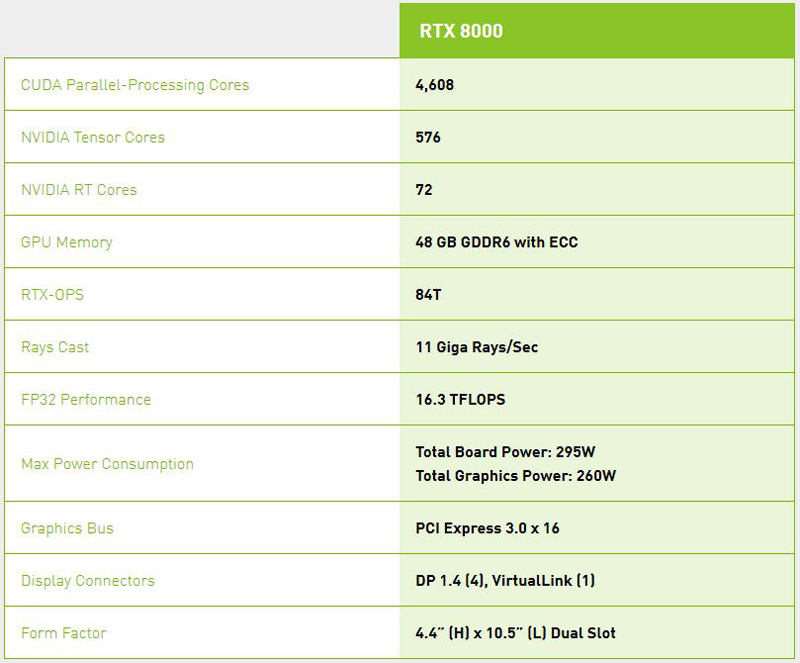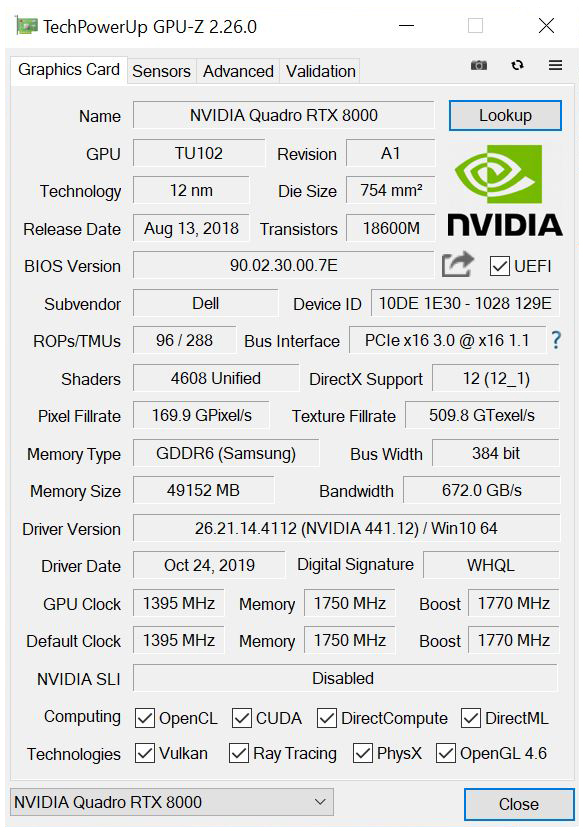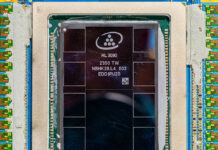NVIDIA Quadro RTX 8000 Specifications
The specifications for the three cards in this range, Titan RTX, Quadro RTX 6000 and Quadro RTX 8000 are similar with the differences we noted in the opening. In the case of our review unit, the Quadro RTX 8000 the main difference is 48GB GDDR6 ECC memory.

This is as many CUDA cores, Tensor cores, and RT cores one can get in the current GPU generation. We have been discussing the Titan RTX and Quadro RTX 6000 quite a bit in our review thus far. To some, that comparison may seem strange, but we wanted to put key compute specs in a table to give our readers a sense of the similarities and differences.

As you can see, the memory configuration is the primary difference. Clock speeds are relatively similar. The cooling setup is very important as the Quadro RTX 8000 is designed to scale beyond two GPUs per system.
Testing the NVIDIA Quadro RTX 8000
Here are the key specs of our test setup:
• Motherboard: ASUS WS C621E SAGE Motherboard
• CPU: 2x Intel Xeon Gold 6134 (8 core / 16 Threads)
• GPU: NVIDIA Quadro RTX 8000
• Cooling: Noctua NH-U14S DX-3647 LGA3647
• RAM: 12x MICRON 16GB Low Profile
• SSD: Samsung PM961 1TB
• OS: Windows 10 Pro Workstation / Ubuntu 18.04 LTS
A quick note here is that our system has ECC on for the Quadro’s memory for all testing.
Here is the obligatory GPU-Z shot of the NVIDIA Quadro RTX 8000:

GPU-Z shows the primary stats of our testing the Quadro RTX 8000. The GPU clocks in at 1,396 MHz and can boost up to 1,770 MHz. Pixel Fillrates run at 169.9 GPixels/s, and Texture Fillrate comes in at 509.8 GTexel/s, while memory runs at 1,750 MHz.
Let us move on and start our testing with computing-related benchmarks.




I disagree with the closing statement, the real competition to this card when you don’t need the memory capacity but do need additional performance is a dual RTX5000 setup and not a single RTX6000. Other than that great article and overview of the RTX8000
For deep learning, or (most?) any machine learning, ECC RAM is unnecessary. 48GB is great though. The more the better.
What’s with the ‘stereo’ connector? Does this thing have an audio output too?
@zeta it’s for audio passthrough to a VR headset, same reason it has the USB-C connector on the back
Something appears to have gone wrong with the Octane benchmark. There is typically a really small difference between the 2080ti and the RTX 8000. Are we sure those are the correct results? 🙂
@Nejc The scene probably needs to address some out-of-core memory on 11GB VRAM cards which is not needed on RTX Titan & RTX 6000/8000
will this run fortnite?
Quadros would blow the doors off all these cards if they weren’t built for wait for it…. REDUNDANCY. Meaning ECC capabilities. Stop comparing Professional grade cards with basic consumer-grade cards. If you cannot comprehend what redundancy is or why it is needed on a Professional basis then you morons just need to learn to shut up. Quadros are not “gaming” cards. Idiots.